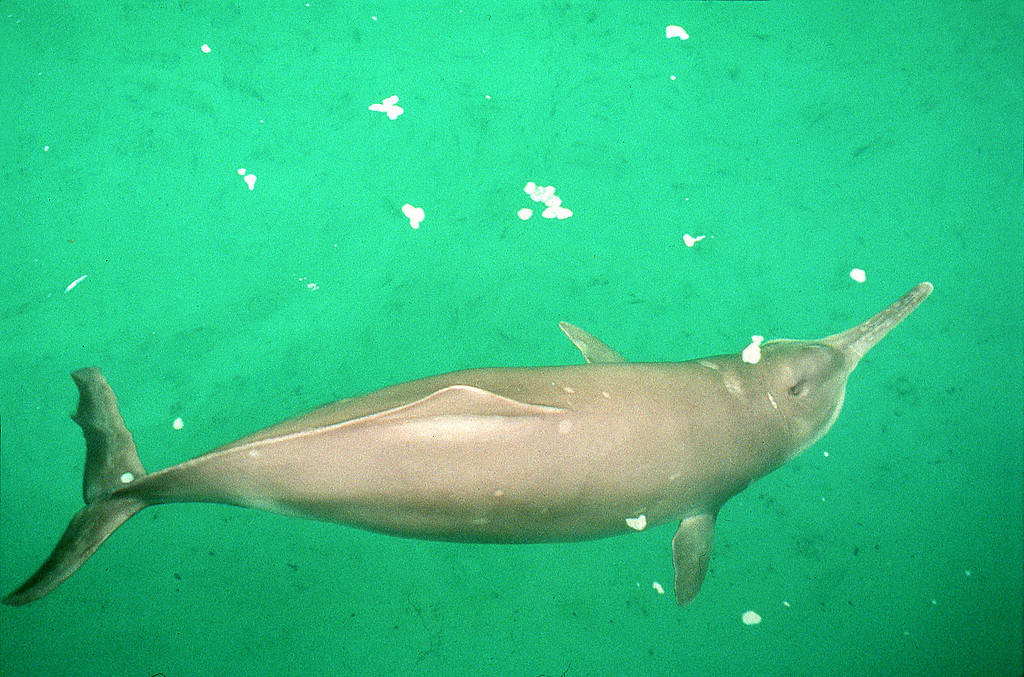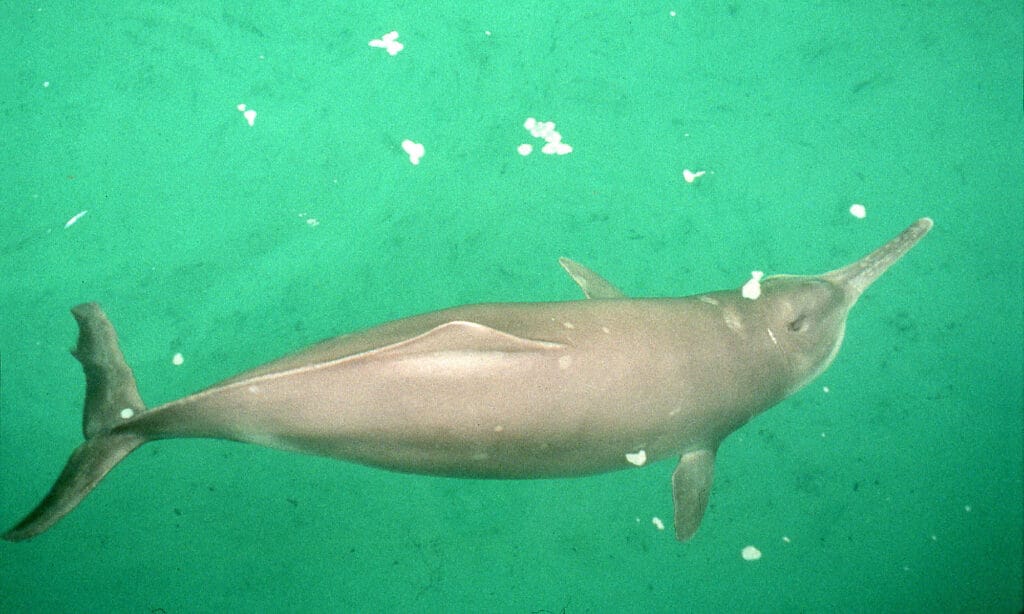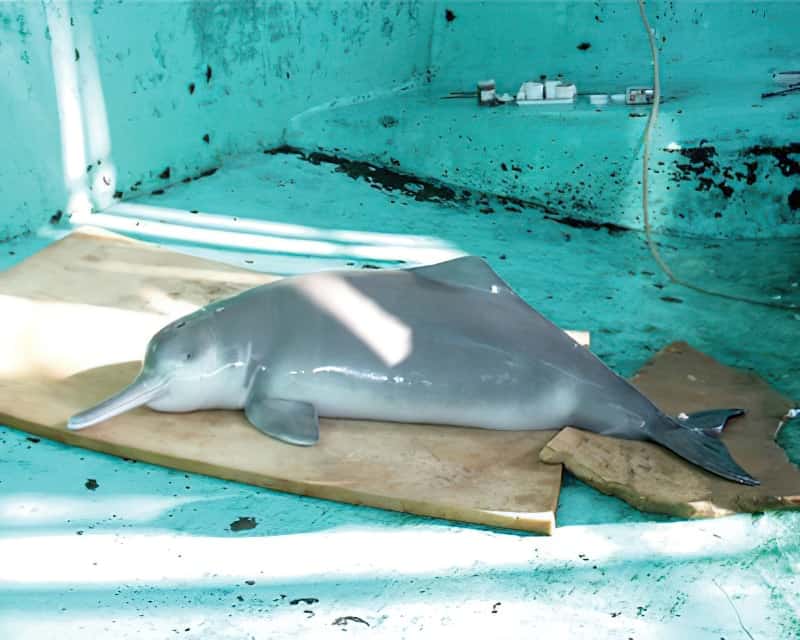When you think of dolphins, you probably don’t think of them living in freshwater rivers. Most people are familiar with bottlenose dolphins, spinner dolphins, and striped dolphins. But dolphins don’t just live in the ocean; there are also several species of river-dwelling dolphins in South America and Asia. These include the famously pink Amazon River dolphin, the Yangtze finless porpoise, the Irrawaddy dolphin, the Indus River dolphin, the Ganges River dolphin, and the tucuxi.
Unfortunately, all the world’s remaining river dolphins face a very real threat of extinction. And, for the baiji, or Chinese River dolphin, extinction has already become a reality. The baiji is the only extinct river dolphin on Earth—so far.
Let’s get to know this incredible vanished species a little better and learn what can be done to save the remaining river dolphins of the world from the same fate.
The Chinese River Dolphin

Baijis made their home in the Yangtze River system of China for an estimated 50 million years.
©iStock.com/EarthViews Productions
The baiji, Lipotes vexillifer, is also known as the Yangtze River dolphin, whitefin dolphin, or Chinese river dolphin. In Chinese, baiji means white dolphin, which is an apt name for this pale, river-dwelling cetacean. These extinct river dolphins made their home in the Yangtze River system of China for an estimated 50 million years. Unfortunately, the baiji was no match for the industrial revolution and its accompanying explosion in human population and exploitation of natural resources.
Habitat and Range
Baiji dolphins once swam the murky, heavily sedimented waters of the lower and middle parts of the Yangtze River. They also lived in Dongting and Poyang, two lakes linked to the middle Yangtze River. These extinct river dolphins were perfectly at home in the dim, dark waters of the Yangtze. Unlike oceanic dolphins, baiji had special adaptations that made them perfect for living in one of China’s busiest and most economically important rivers.
Appearance and Behavior
Baijis were recognizable as dolphins, but only just. They had long, thin snouts full of matching, conical teeth, and blowholes on top of their heads. But, unlike oceanic dolphins, which have large eyes, the baiji had very small, practically useless eyes. Because they lived in such a murky environment, seeing well didn’t provide much advantage. Instead, they had highly developed organs for echolocation and could get around underwater by ‘pinging’ for fish and landscape features.
Like all dolphins, the baiji relied on a diet of fish. Scientists believe they lived in pods of 6-8 individuals, with mothers nursing calves for their first several months of life. These extinct dolphins are believed to have lived around 30 years, though no one can be certain of their exact lifespan. Because of their rapid extinction, little is known about the behavior of these incredible bygone marine mammals.
What Happened to the Baiji River Dolphin?

Some factors like overfishing, shipping traffic, habitat destruction, and pollution led to the extinction of the baiji.
©iStock.com/EarthViews Productions
Baiji river dolphins inhabited the waters of the Yangtze, and its accompanying lakes, for millions of years. Unfortunately for them, the Yangtze river and its surrounding area is home to a large portion of the world’s population. The Yangtze is important both as a trade route for cargo vessels and as a food source for commercial fishermen.
Let’s look at some factors that led to the extinction of the Chinese river dolphin.
1. Overfishing
In the 1950s, surveys showed that several thousand river dolphins lived in the Yangtze. But, over the next half-century, overfishing of the river led to a reduction in fish—the sole food of the baiji—and dolphins dying as bycatch. Death by bycatch occurs when fishermen accidentally kill species, like sharks and dolphins, that they aren’t actively fishing for. Unfortunately, several destructive fishing practices, like electrofishing, rolling hooks, and gill nets, had a devastating impact on the baiji.
2. Increased Shipping Traffic
As the Yangtze River grew in importance, so did the number of vessels utilizing its waters. With more and larger boats, the incidences of dolphin death from propeller or ship impact increased. Despite their advanced sonar ability, Chinese river dolphins just couldn’t avoid every ship on the river.
3. Habitat Destruction
Increasing shipping traffic, increasing human population, and the building of large dams all negatively impacted these extinct river dolphins. Unfortunately, baiji just couldn’t adapt fast enough to the rapidly changing landscape of the Yangtze River in the second half of the twentieth century.
4. Pollution
Chinese river dolphins were apex predators in their ecosystem. And unfortunately, when pollution, including noise pollution, tips the balance, the creatures at the top of the food chain are often the first to go. Pollution, along with increased shipping traffic, habitat destruction and modification, and most especially overfishing, all led to the rapid decline and extinction of the baiji.
Is the Baiji River Dolphin Extinct?

The last confirmed living baiji died in 2002.
©Institute of Hydrobiology, Chinese Academy of Sciences / public domain, Wikimedia Commons – License
The last confirmed living baiji died in 2002. As of 2022, it has been 20 years since the last confirmed sighting of this unfortunate casualty of human error. Further, Chinese river dolphins were the only members of their family, a family of one that diverged from all other cetaceans (whales, dolphins, and porpoises) millions of years ago. They have the tragic distinction of being the first cetaceans driven to extinction by humans in recent history.
Saving the World’s Remaining Marine Mammals
Today, conservation scientists believe that we can learn from the mistakes made in the case of these extinct river dolphins. Across the world, over one million plant and animal species are currently in danger of extinction. These include the Yangtze finless porpoise, which still lives in the same waters it once shared with the baiji.
Currently, the most critically endangered cetacean on the planet is the vaquita. The population of these small marine mammals is estimated to be less than 20 individuals. If the proper conservation steps aren’t taken, and soon, many more species could soon join the baiji in the ranks of exterminated species.
But, not all hope is lost. The first step you can take in conserving the natural diversity, and health, of our planet is to do your research—which you’re already doing!
Up Next:
The photo featured at the top of this post is © iStock.com/EarthViews Productions
Sources
- , Available here: https://us.whales.org/whales-dolphins/species-guide/baiji/
- , Available here: https://www.fisheries.noaa.gov/species/chinese-river-dolphin
- , Available here: https://www.nhm.ac.uk/discover/baiji-why-this-extinct-river-dolphin-still-matters.html
- , Available here: https://iucn-csg.org/baiji/
Thank you for reading! Have some feedback for us? Contact the AZ Animals editorial team.






